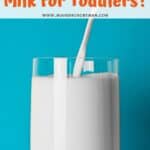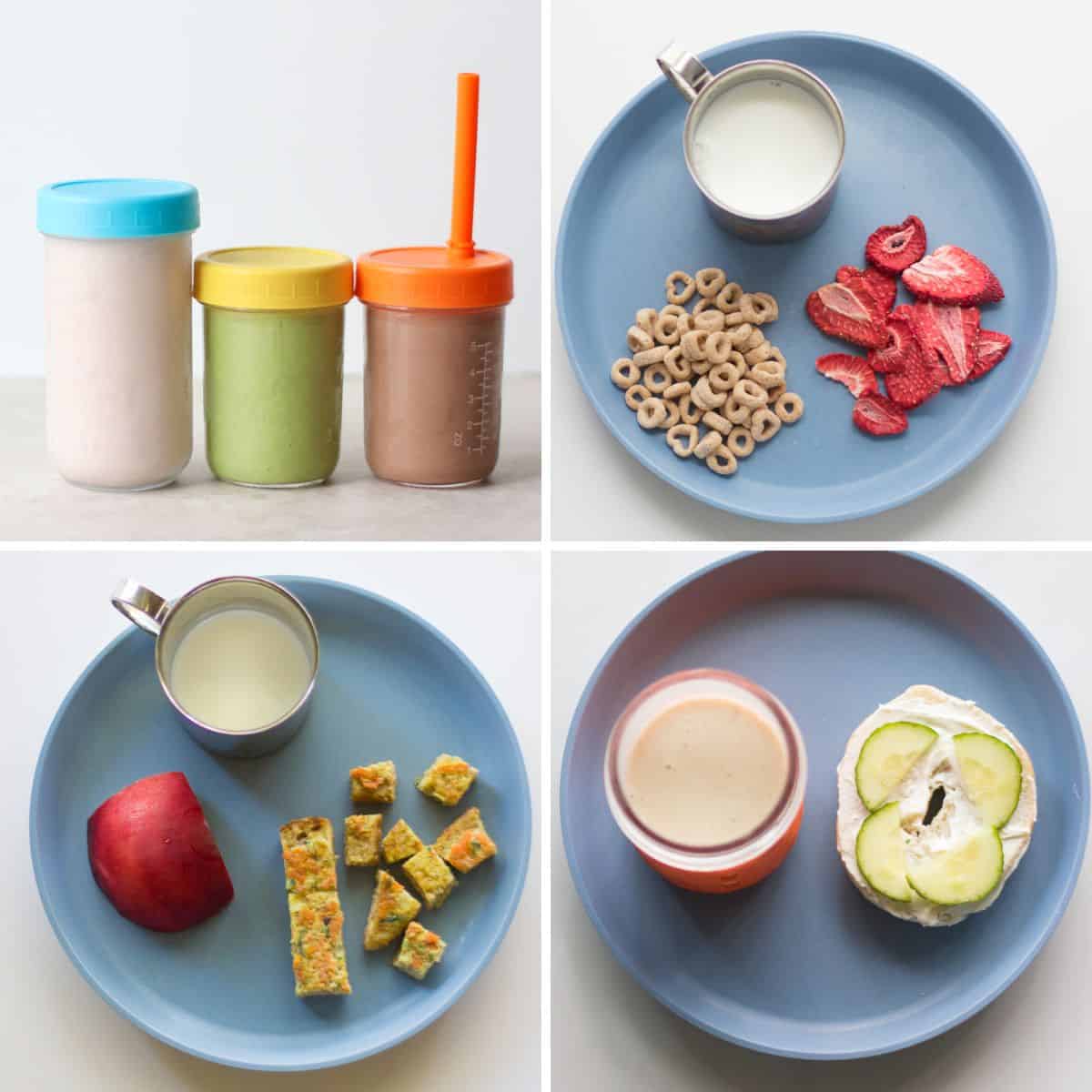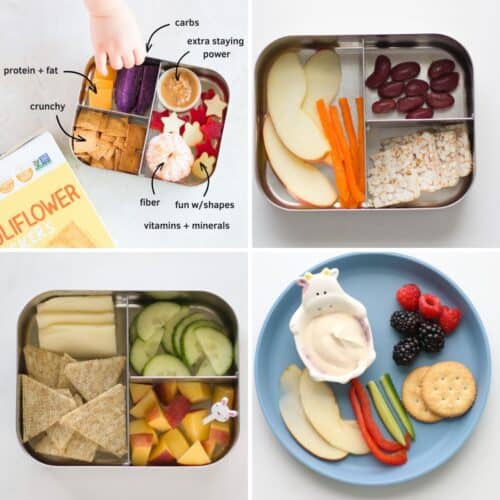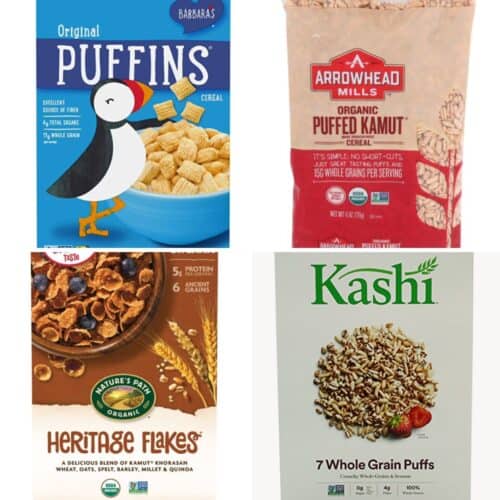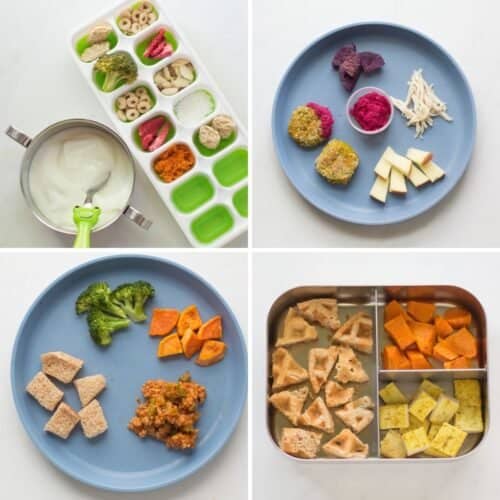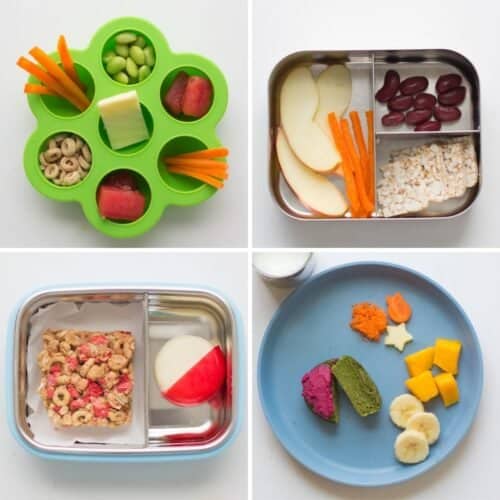When to Introduce Milk to Babies
If you’re breastfeeding, you might be feeling confused as to when to introduce milk to your child’s diet and whether or not it’s necessary to do so. Just like with many transitions, it’s scary to move from breastfeeding/formula to milk, isn’t it? It is so important to take a gentle and slow approach when it comes to weaning as well as the current recommendations on how long to continue breastfeeding. First, know that breastmilk will continue to offer your child many benefits from nutritional, immunological, and emotional standpoints. However, after one year of age, getting nutrients from foods becomes a priority as milk, whether it’s breastmilk, cow’s milk, or plant-based alternatives, cannot meet all their needs to support their growth and development. If your child is still nursing a lot after one year of age and isn’t showing much interest in food, try offering the meal before you nurse. Once your child starts to eat more food, the number of sessions should naturally decrease. The goal here is that by age two, your child will rely less on liquid nutrition and more on solid food.
Milk Nutrition Comparison Chart
Here’s a chart for a comparison of common unflavored, unsweetened milk alternatives. The numbers are based on USDA nutrient database. Do check your labels as protein and vitamin content may differ depending on the brand you get.
Best Milk for 1 to 2 year olds
The American Academy of Pediatrics recommends WHOLE cow’s milk in the absence of a dairy allergy. That’s because, as you can see in the chart above, cow’s milk is an excellent and convenient source of many of the key nutrients. It’s also readily available and cost-effective compared to others. Now, I know there’s a lot of misinformation out there that you MUST introduce cow’s milk at a year. That’s simply not true. Again, referring to the chart, breastmilk has a higher fat content compared to whole cow’s milk, and the nutrients are more bioavailable as well, meaning they are more easily absorbed in the body. As long as you’re nursing at least 3-4 times a day, there’s no need to add cow’s milk. However, the two key nutrients during this age, calcium and vitamin D, are quite low in breastmilk. Therefore, you must ensure that your child is getting adequate amounts through their diet. More on this below.
Best Milk for 2 years and older
While the recommendation is to switch to low-fat milk at this time to reduce total fat intake, there’s a lack of evidence to show its overall benefit. Fat is an ESSENTIAL part of a well-balanced diet and super important for not only babies but young toddlers. They continue to have increased caloric requirements for growth and brain development. Not to mention, a low-fat diet often leads to high carbohydrate intake with inadequate nutrients. So rather than trying to eliminate fat from your child’s diet, focus on offering healthy fats! Saturated fat in whole milk, cheese, or coconut oil is different from the saturated fat found in pizza, fried foods, baked goods, and other processed meat products. Trans fat, is one type of fat you do want to avoid completely!
Best Non-Dairy Milk for Babies After 1
As you can see in the milk comparison chart above, the best choices that will help meet your toddler’s nutritional needs are soy and pea milks. If it’s necessary for your child to consume milk other than these options, it may be helpful to consult with your pediatrician or a registered dietitian to make sure that your child is getting the adequate nutrition they need to for them to grow and thrive.
Selecting dairy-free milk:
Look at the ingredient list! Oftentimes these milk have a really long list. Shorter the better. Make sure to look for plain, unsweetened option. Shake up the bottle really well before serving as the fortified nutrients settle to the bottom. Make sure it’s fortified with calcium (you’ll see it listed in the ingredient list either as calcium carbonate or tri-calcium phosphate. Choose the one with calcium carbonate as it’s more absorbable.) and vitamin D.
Is Soy Milk Safe for Babies and Toddlers?
I get asked this question A LOT, so I thought it’s worth mentioning here. Many parents are concerned about serving soy products to their children due to fear that it may cause cancer or feminization in boys. It’s true that soy foods contain isoflavones (a phytoestrogen), which are similar to hormone estrogen in structure. However, phytoestrogen and estrogen are NOT the same, and they behave differently in the body. All this to say, a moderate consumption of 1 to 2 servings of whole soy foods, such as tofu, soy milk, edamame, and soy nuts are deemed safe, according to the American Institute for Cancer Research. A serving equals: 1 cup of soymilk, 1/2 cup of tofu, tempeh, or soybeans. Avoid processed soy products, like soy burgers, bars, etc.
How Much Milk Do Toddlers Need?
The American Academy of Pediatrics recommends 2-3 servings of dairy per day, or about 16 to a maximum of 24 ounces of milk per day. Here are the recommended portion sizes for each food group.
When is the Best Time to Serve Milk?
Remember, milk is filling and so if offered throughout the day, it can sabotage their appetite and lead to grazing and not eating their meals. So the best time to drink milk is with their snacks/meals.
Do Toddlers Need Milk?
Yes and no. Milk is such a convenient way to provide the key nutrients that they need. However, as long as your child is getting the adequate amounts of protein, fat, calcium, and vitamin D through food, it’s not required.
To Sum
The best milk for babies after the age of one is whole cow’s milk. Best non-dairy milks are soy milk and pea milk. It is not necessary for toddlers to drink milk, but you do want to make sure they’re getting adequate protein, calcium, and vitamin D from other foods.
More Helpful Resources
Fat: avocado, nuts, seeds, fatty fish, eggs, oils (e.g. olive, avocado, coconut, sesame, walnut, canola), whole fat or 2% dairy products. Protein: meats, poultry, fish, peas, beans, lentils, eggs, grains, nuts, seeds, cheese, yogurt. Calcium: yogurt, cheese, green leafy vegetables (spinach, collards, kale), broccoli, cabbage, tofu and other soy products, beans, nuts and seeds, seafood/fish (with bones), fortified foods (e.g. cereals, bread), backstrap molasses Vitamin D: this is a challenging nutrient to meet from our diets so you may need to supplement if you’re not doing cow’s milk. It’s found in the flesh of the fatty fish (like salmon, tuna, mackerel), beef liver, cheese, egg yolks, mushrooms, and fortified foods like cheese, yogurt, and cereals.
